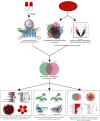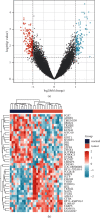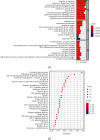Identification of Bioactive Compounds and Potential Mechanisms of Kuntai Capsule in the Treatment of Polycystic Ovary Syndrome by Integrating Network Pharmacology and Bioinformatics
- PMID: 35528524
- PMCID: PMC9073551
- DOI: 10.1155/2022/3145938
Identification of Bioactive Compounds and Potential Mechanisms of Kuntai Capsule in the Treatment of Polycystic Ovary Syndrome by Integrating Network Pharmacology and Bioinformatics
Abstract
Objective: This study elucidates the potential therapeutic targets and molecular mechanisms of KTC in the treatment of PCOS.
Materials and methods: Using the Traditional Chinese Medicine System Pharmacology Database and Analysis Platform (TCMSP), the active ingredients and potential targets of KTC were obtained. The Gene Expression Omnibus (GEO) database was used to find differentially expressed genes (DEGs) related to PCOS. Search the CTD, DisGeNet, genecards, NCBI, OMIM, and PharmGKB databases for therapeutic targets related to PCOS. The intersection of potential targets, DEGs, and therapeutic targets was submitted to perform bioinformatics analysis by R language. Finally, the analyses' core targets and their corresponding active ingredients were molecularly docked.
Results: 88 potential therapeutic targets of KTC for PCOS were discovered by intersecting the potential targets, DEGs, and therapeutic targets. According to bioinformatics analysis, the mechanisms of KTC treatment for PCOS could be linked to IL-17 signaling route, p53 signaling pathway, HIF-1 signaling pathway, etc. The minimal binding energies of the 5 core targets and their corresponding ingredients were all less than -6.5. Further research found that quercetin may replace KTC in the treatment of PCOS. Discussion and Conclusions. We explored the active ingredients and molecular mechanisms of KTC in the treatment of PCOS and found that quercetin may be the core ingredient of KTC in the treatment of PCOS.
Copyright © 2022 Xiushen Li et al.
Conflict of interest statement
The authors declare that they have no conflicts of interest.
Figures








References
-
- Shen W., Jin B., Pan Y., et al. The effects of traditional Chinese medicine-associated complementary and alternative medicine on women with polycystic ovary syndrome. Evidence-based Complementary and Alternative Medicine: eCAM . 2021;2021, article 6619597 doi: 10.1155/2021/6619597. - DOI - PMC - PubMed
MeSH terms
Substances
LinkOut - more resources
Full Text Sources
Medical
Research Materials
Miscellaneous

